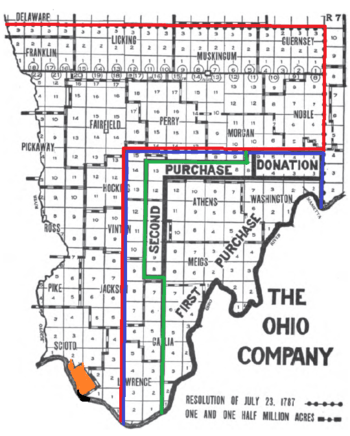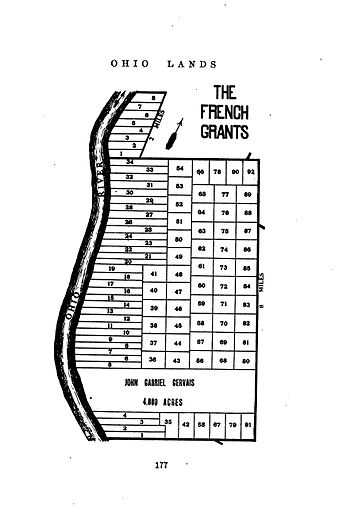Scioto Company


The Scioto Company was a French institution which granted worthless deeds in the Northwest Territory, later Ohio, to French colonists.
The Scioto Land Company was organized by Colonel William Duer and others in 1787 and officially organized in 1789 as the Compagnie du Scioto in Paris by Joel Barlow, the agent of Duer and his associates abroad (William Playfair, an Englishman, plus six Frenchmen).
This company had arranged with the Ohio Company, in 1787, for the use of about 4,000,000 acres (16,000 km2), (another source says about 3,500,000 acres (14,000 km2)),[1] north of the Ohio River and east of the Scioto River, on which the Ohio Company had secured an option only. The dishonesty of those who conducted the sales in France, the unbusinesslike methods of Barlow, and the failure of Duer and his associates to meet their contract with the Ohio Company, caused the collapse of the Scioto Company early in 1790, and two subsequent attempts to revive it failed.
Meanwhile about 150,000 acres (610 km2) had been sold to prospective settlers, companies and individuals in France. On February 19, 1791, 218 of these purchasers left Havre de Grace, in France, and arrived in Alexandria, District of Columbia, now Alexandria, Virginia, on the May 3 following.
On their arrival, they were told that the Scioto Company owned no land. When they arrived at Marietta, Ohio, about fifty of them landed. In October 1791, rest of the company proceeded to Gallipolis, which was laid out about that time, and where rude huts had been built for them, were assured by the agent that the place lay within their purchase.
This land, however, fell within the limits of the tract bought outright by the Ohio Company, which sold it to the Scioto Company, and to which it reverted on the failure of the Scioto Company to pay.
In 1794, William Bradford, the U.S. Attorney General, decided that all rights in the 4,000,000 acres (16,000 km2) on which the Ohio Company had secured an option for the Scioto Company were legally vested in the Ohio Company.
In 1795, the Ohio Company sold to the French settlers for $1.25 an acre ($309/km²) the land they occupied and adjacent improved lots,[2] and the United States government granted to them 24,000 acres (97 km2) in the southern part of what is now Scioto County, Ohio in 1795,[3] known as the First French Grant. Four thousand of those acres were for John Gabriel Gervais, and 20,000 to be divided among the remaining inhabitants of Gallipolis.
Eight inhabitants of Gallipolis somehow missed out on the 1795 distribution, and so Congress, in 1798,[4] made an additional adjacent grant, the Second Grant, of 1,200 acres (4.9 km2) for these eight. Most residents of Gallipolis never occupied the First Grant or the Second Grant, instead either selling them, or sending tenants to occupy them.[5]
Notes
- ↑ Peters 1918 : 178
- ↑ Hulbert, Archer Butler, ed. (1917). The Records of the Original Proceedings of the Ohio Company. Marietta College Historical Collections 2. Marietta Historical Commission. p. 171.
- ↑ 1 Stat. 442 - Text of Act of March 3, 1795 Library of Congress
- ↑ 6 Stat. 35 - Text of Act of June 25, 1798 Library of Congress
- ↑ Peters 1918 : 176–183
References
 This article incorporates text from a publication now in the public domain: Chisholm, Hugh, ed. (1911). Encyclopædia Britannica (11th ed.). Cambridge University Press.
This article incorporates text from a publication now in the public domain: Chisholm, Hugh, ed. (1911). Encyclopædia Britannica (11th ed.). Cambridge University Press.- Peters, William E (1918). Ohio Lands and Their Subdivision. W.E. Peters.